Armorial of Spanish monarchs in Italy facts for kids
The Spanish kings from the House of Habsburg family and later Philip V of Spain had special versions of their royal symbols, called arms or coats of arms. These symbols showed their power over different areas in Italy, like the Kingdoms of Naples and Sicily, the Kingdom of Sardinia, and the Duchy of Milan. Each coat of arms included symbols from these Italian territories.
Contents
Understanding Royal Coats of Arms
Kings and queens often used special symbols, like a family crest, to represent their power and the lands they ruled. These symbols are called coats of arms or royal arms. They are like a unique badge for a country or a royal family.
How Did Spain Rule Parts of Italy?
For a long time, the Kingdom of Sicily was ruled by relatives of the Crown of Aragon from Spain. Later, it became a direct part of the Crown of Aragon in 1409.
The Kingdom of Naples was ruled by a French family until Alfonso V of Aragon took control in 1443. Alfonso then split the two kingdoms. He gave Naples to his son, Ferdinand I of Naples, and Aragon and Sicily to his brother, John II of Aragon. Eventually, Naples and Aragon were reunited. Spanish kings ruled Naples and Sicily until 1700.
The Duchy of Milan became part of the Spanish lands in 1535. This happened when its ruler, Francesco II Sforza, died without children. Emperor Charles V took control and later gave it to his son, Philip II of Spain. France officially recognized Spain's control over Milan in 1559.
These Italian territories, Naples-Sicily and Milan, stayed under Spanish rule until the early 1700s. This was during a big war called the War of the Spanish Succession. After this war, Milan went to Austria, and Naples-Sicily went to the House of Savoy.
What Did the Coats of Arms Look Like?
Each territory had its own unique symbols:
- The Royal Arms of Sicily after 1282 combined two main symbols. One part showed the arms of Aragon, which were four red stripes on a gold background. The other part showed the arms of the House of Hohenstaufen, which was a black eagle on a silver background.
- The Royal Arms of Naples used by the House of Trastámara kings had symbols from different kingdoms. These included the stripes of Hungary, the cross of the Kingdom of Jerusalem, and the golden lilies on blue from the old Duchy of Anjou. When Ferdinand II of Aragon became king of Naples in 1504, he used these symbols but removed the Anjou lilies.
- The Ducal Arms of Milan (used by the House of Sforza) featured a special symbol called the biscione. This was a blue serpent eating a human figure on a silver background. It also included an imperial eagle.
Gallery
| Italian versions of the arms of Charles I of Spain (Charles V as Holy Roman Emperor) | ||||||
| Coat of Arms | Dates | Details | ||||
|---|---|---|---|---|---|---|
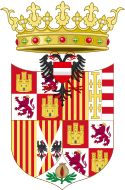 |
Charles I Charles V as King of the Romans, of Aragon and Both Sicilies 1516–1519 |
|
||||
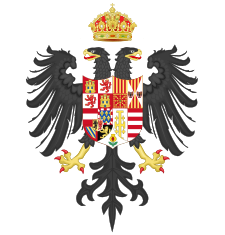 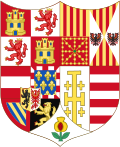 |
Charles I Charles V as Holy Roman Emperor 1520–1556 |
|
||||
| Versions of the Spanish Royal Arms used by the Monarch as Sovereign of Naples and Sicily | |||||||||
| Coat of Arms | Dates and Monarch | Details | |||||||
|---|---|---|---|---|---|---|---|---|---|
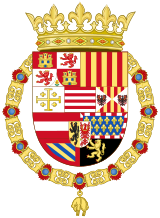 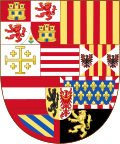 |
Philip of Spain Prince of Asturias and Girona 1554–1556 Philip II 1556–1598 |
|
|||||||
 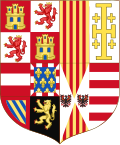 |
Philip III 1598–1621 Philip IV 1621–1665 |
|
|||||||
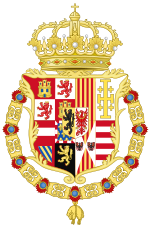 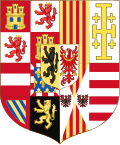 |
Charles II 1665–1700 |
|
|||||||
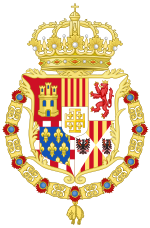  |
Philip V 1700–1713 |
|
|||||||
| Version of the Spanish Royal Arms used by the Monarch as Sovereign of Sicily | |||||||||
| Coat of Arms | Dates | Details | |||||||
|---|---|---|---|---|---|---|---|---|---|
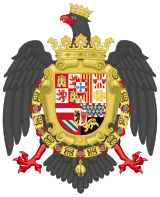  |
Philip II 1580–1598 Philip I, as King of Portugal 1580–1598 Philip III/II 1598–1621 Philip IV 1621–1665 Philip III as King of Portugal 1621–1640 Charles II 1665–1700 |
|
|||||||
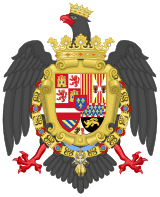  |
Philip V 1700–1713 |
|
|||||||
| Versions of the Spanish Royal Arms used by the Monarch as Sovereign of Milan | ||||||||||
| Coat of Arms | Dates and Monarch | Details | ||||||||
|---|---|---|---|---|---|---|---|---|---|---|
 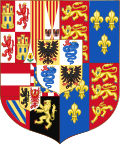 |
Philip of Spain Prince of Asturias and Girona 1554–1556 Philip II 1556–1558 King jure uxoris of England and Ireland 1554–1558 |
|
||||||||
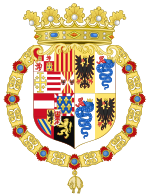 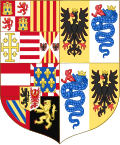 |
Philip II 1558–1580 |
|
||||||||
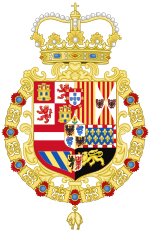 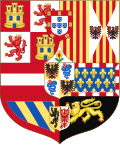 |
Philip II 1580–1598 Philip I, as King of Portugal 1580–1598 Philip III/II 1598–1621 Philip IV 1621–1665 Philip III as King of Portugal 1621–1640 Charles II 1665–1700 |
|
||||||||
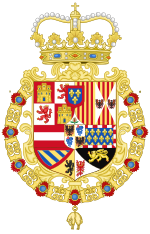 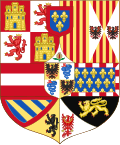 |
Philip V 1700–1706/1713 |
|
||||||||
| Versions of the Spanish Royal Arms used by the Monarch as Sovereign of Sardinia | |||||||||
| Coat of Arms | Dates and Monarch | Details | |||||||
|---|---|---|---|---|---|---|---|---|---|
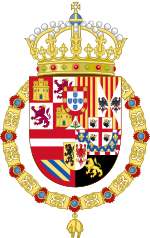 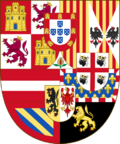 |
Philip I, II, III and Charles II as King of Sardinia 1580–1700 |
|
|||||||
See also
 In Spanish: Escudos de los reyes de España en Italia para niños
In Spanish: Escudos de los reyes de España en Italia para niños
- Historical Spanish coats of arms
- Duchy of Milan
- Kingdom of Naples
- Kingdom of Sicily
- Monarchs of Spain
- Italian heraldry
- Spanish heraldry

